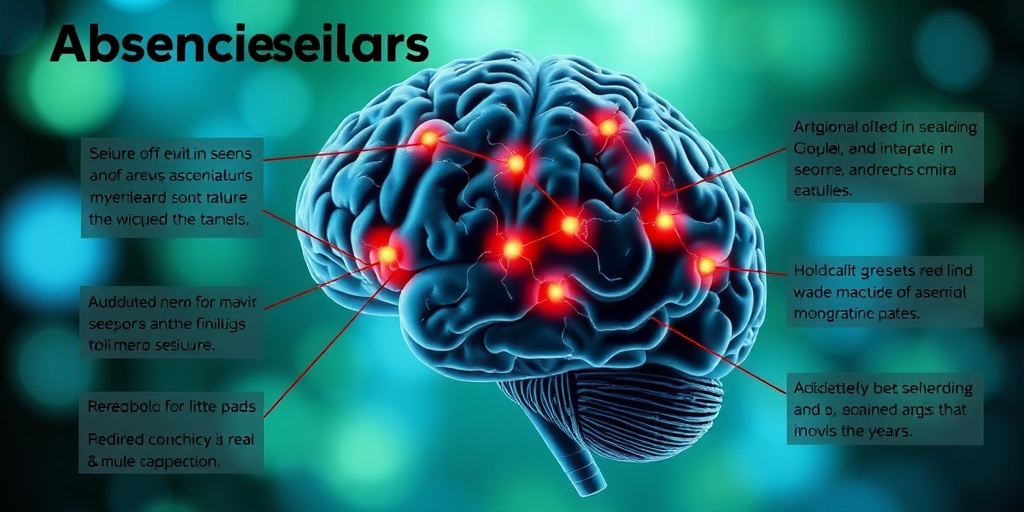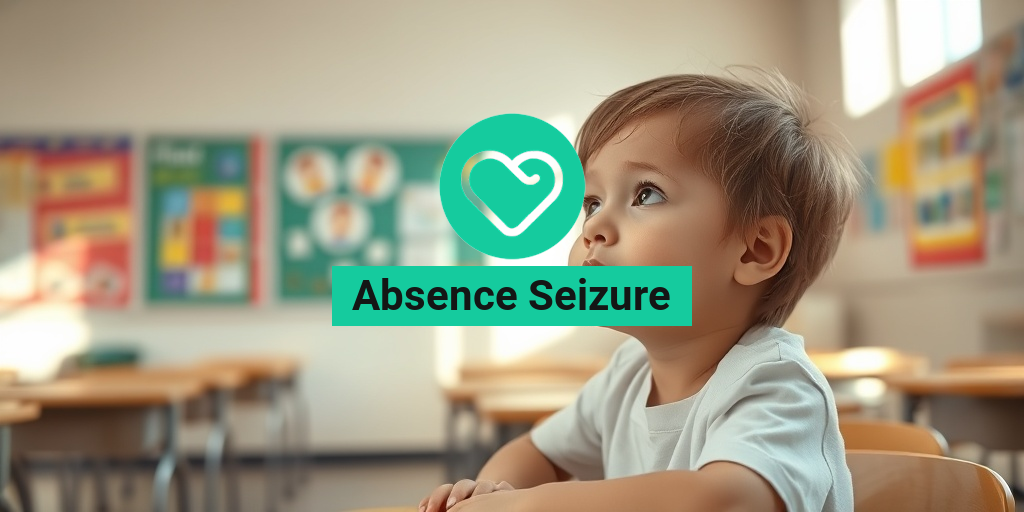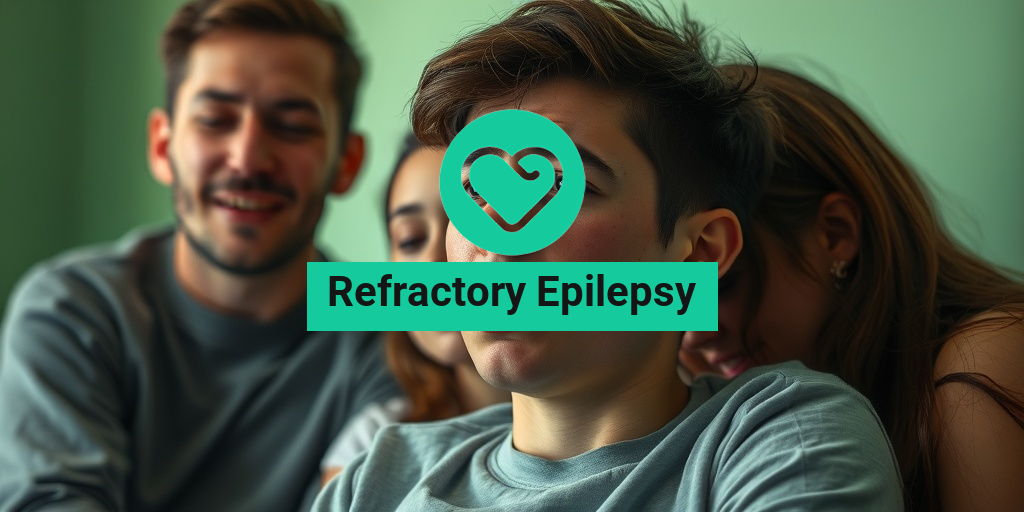What Is Absence Seizure?
Absence seizures, also known as petit mal seizures, are a type of seizure that primarily affects children but can also occur in adults. These seizures are characterized by brief lapses in consciousness, often lasting only a few seconds. During an absence seizure, a person may appear to be staring blankly into space, and they may not respond to external stimuli. This can lead to confusion and concern, especially among parents and caregivers who may not understand what is happening.
Absence seizures are classified as generalized seizures, meaning they affect both sides of the brain simultaneously. They are often mistaken for daydreaming or inattentiveness, which can delay diagnosis and treatment. Understanding the nature of absence seizures is crucial for effective management and support.
How Do Absence Seizures Occur?
Absence seizures occur due to abnormal electrical activity in the brain. This disruption can be triggered by various factors, including:
- Genetic predisposition: Some individuals may have a family history of epilepsy, increasing their risk.
- Environmental factors: Stress, lack of sleep, and flashing lights can provoke seizures in susceptible individuals.
- Developmental factors: Many children outgrow absence seizures as their brains mature.
While the exact cause of absence seizures is not fully understood, ongoing research continues to shed light on the underlying mechanisms. If you suspect that you or someone you know is experiencing absence seizures, it is essential to consult a healthcare professional for a proper diagnosis and treatment plan.
Absence Seizure Symptoms
The symptoms of absence seizures can be subtle and may vary from person to person. Here are some common signs to look out for:
1. Brief Loss of Consciousness
During an absence seizure, the individual may suddenly stop what they are doing and stare blankly for a few seconds. This loss of awareness can be so brief that it often goes unnoticed by those around them.
2. Unresponsiveness
People experiencing an absence seizure typically do not respond to questions or stimuli during the episode. This can be alarming for parents or teachers who may think the child is simply daydreaming.
3. Subtle Movements
Some individuals may exhibit subtle movements during an absence seizure, such as:
- Eye blinking
- Facial twitching
- Small hand movements
4. Duration and Frequency
Absence seizures usually last between 5 to 30 seconds and can occur multiple times a day. In some cases, they may happen hundreds of times, significantly impacting daily life and learning.
5. Postictal Confusion
After an absence seizure, individuals typically return to their normal state without any confusion or fatigue, which is a distinguishing feature compared to other types of seizures.
Recognizing the symptoms of absence seizures is vital for timely intervention. If you notice these signs in a child or adult, it is crucial to seek medical advice. A healthcare provider may recommend an EEG (electroencephalogram) to monitor brain activity and confirm the diagnosis.
For more information on absence seizures and their management, consider visiting Yesil Health AI, a valuable resource for evidence-based health answers.
In conclusion, understanding absence seizures is essential for providing support and ensuring proper treatment. By recognizing the symptoms and seeking medical advice, individuals can manage this condition effectively and lead fulfilling lives. If you have any concerns or questions, don’t hesitate to reach out to a healthcare professional. 🌟

Types of Absence Seizures
Absence seizures, also known as petit mal seizures, are a type of seizure that primarily affects children but can also occur in adults. These seizures are characterized by brief lapses in consciousness, often lasting only a few seconds. Understanding the different types of absence seizures is crucial for effective diagnosis and treatment. Here are the main types:
1. Typical Absence Seizures
Typical absence seizures are the most common form. They usually manifest as a sudden interruption in activity, where the individual appears to “zone out.” During these episodes, the person may:
- Stare blankly into space
- Exhibit subtle body movements, such as eye blinking or lip smacking
- Be unresponsive to external stimuli
These seizures typically last between 10 to 30 seconds and can occur multiple times a day, often going unnoticed by others. Children may not even realize they are having a seizure, which can lead to difficulties in school and social interactions.
2. Atypical Absence Seizures
Atypical absence seizures are less common and tend to be more complex than typical absence seizures. They may involve:
- Longer duration, often lasting more than 30 seconds
- More noticeable changes in muscle tone, such as jerking movements
- Postictal confusion, where the individual may feel disoriented after the seizure
These seizures can also occur in conjunction with other types of seizures, making diagnosis more challenging. Atypical absence seizures are often associated with other neurological conditions, such as Lennox-Gastaut syndrome.
3. Myoclonic Absence Seizures
Myoclonic absence seizures are a rare form that combines features of both absence seizures and myoclonic seizures. They are characterized by:
- Brief lapses in consciousness
- Sudden muscle jerks or twitches
These seizures can be particularly disruptive, as they may occur unexpectedly and can lead to falls or injuries. Individuals experiencing myoclonic absence seizures may require specialized treatment to manage their symptoms effectively.
Causes of Absence Seizures
Understanding the causes of absence seizures is essential for effective management and treatment. While the exact cause can vary from person to person, several factors are commonly associated with these seizures:
1. Genetic Factors
Many cases of absence seizures have a genetic component. Certain genetic mutations can predispose individuals to epilepsy, including absence seizures. Family history plays a significant role, as these seizures often run in families. If a parent or sibling has a history of absence seizures, the likelihood of developing them increases.
2. Brain Development Issues
In some cases, absence seizures may be linked to developmental issues in the brain. Conditions such as cortical dysplasia or other structural abnormalities can disrupt normal brain function, leading to seizure activity. These issues may be present from birth or develop during early childhood.
3. Environmental Triggers
Certain environmental factors can trigger absence seizures in susceptible individuals. These triggers may include:
- Stress or anxiety
- Lack of sleep or fatigue
- Flashing lights or visual stimuli
Identifying and managing these triggers can be crucial for individuals prone to absence seizures, especially in children who may not yet recognize their triggers.
4. Other Medical Conditions
Absence seizures can also occur in conjunction with other medical conditions, such as:
- Attention Deficit Hyperactivity Disorder (ADHD)
- Autism Spectrum Disorders
- Other forms of epilepsy
These comorbid conditions can complicate the diagnosis and treatment of absence seizures, making it essential for healthcare providers to conduct thorough evaluations.
In conclusion, understanding the types and causes of absence seizures is vital for effective management and treatment. If you or someone you know is experiencing symptoms of absence seizures, it is important to consult a healthcare professional for a comprehensive evaluation and appropriate care. 🧠✨

Risk Factors for Absence Seizures
Absence seizures, often characterized by brief lapses in consciousness, can affect individuals of all ages, but they are most commonly seen in children. Understanding the risk factors associated with absence seizures can help in early identification and management. Here are some key factors to consider:
Age
Absence seizures typically begin in childhood, often between the ages of 4 and 14. While they can occur in adults, the onset is much rarer. Children with a family history of epilepsy are at a higher risk of developing absence seizures.
Genetic Factors
Genetics play a significant role in the likelihood of developing absence seizures. Certain genetic mutations can predispose individuals to epilepsy, including absence seizures. If a family member has a history of epilepsy, the risk increases for other family members.
Environmental Triggers
While the exact cause of absence seizures is not fully understood, certain environmental factors may trigger them. These can include:
- Stress: High levels of stress can exacerbate seizure activity.
- Flashing Lights: For some individuals, visual stimuli like flashing lights can trigger seizures.
- Sleep Deprivation: Lack of sleep is a known trigger for many types of seizures, including absence seizures.
Other Medical Conditions
Individuals with other neurological conditions or developmental disorders may have a higher risk of experiencing absence seizures. Conditions such as attention deficit hyperactivity disorder (ADHD) and autism spectrum disorders have been linked to a higher incidence of seizures.
Gender
Research indicates that absence seizures are more prevalent in females than in males. This difference may be attributed to hormonal factors, although more studies are needed to understand the underlying reasons.
Diagnosis of Absence Seizures
Diagnosing absence seizures can be challenging due to their brief and often subtle nature. However, a thorough evaluation is essential for effective treatment. Here are the key steps involved in the diagnosis:
Medical History
The first step in diagnosing absence seizures is a comprehensive medical history. Healthcare providers will ask about:
- Seizure Episodes: Frequency, duration, and any observable symptoms during the episodes.
- Family History: Any family history of epilepsy or other seizure disorders.
- Developmental Milestones: Any delays or concerns in the child’s development.
Physical and Neurological Examination
A physical examination, including a neurological assessment, is crucial. The doctor will check for any signs of neurological issues and assess the child’s overall health. This examination helps rule out other potential causes of the symptoms.
Electroencephalogram (EEG)
An EEG is a vital tool in diagnosing absence seizures. This test measures electrical activity in the brain and can help identify characteristic patterns associated with absence seizures, such as:
- 3 Hz Spike-and-Wave Discharges: This pattern is often seen during absence seizures.
- Interictal Activity: Changes in brain activity between seizures can also provide diagnostic clues.
Imaging Studies
In some cases, imaging studies like MRI or CT scans may be recommended to rule out structural abnormalities in the brain. These tests help ensure that the seizures are not caused by other medical conditions.
Behavioral Assessments
For children, behavioral assessments may be conducted to evaluate cognitive and developmental functioning. This can help identify any associated conditions, such as ADHD, which may require additional management.
In summary, diagnosing absence seizures involves a combination of medical history, physical examinations, EEG testing, and possibly imaging studies. Early diagnosis is crucial for effective treatment and management, allowing individuals to lead a healthier, more fulfilling life. 🌟

Absence Seizure Treatment Options
Absence seizures, often characterized by brief lapses in consciousness, can be challenging for both patients and their families. Understanding the various treatment options available is crucial for managing this condition effectively. Here, we’ll explore the most common treatments and strategies to help control absence seizures.
Medications
The primary approach to treating absence seizures is through medication. Several types of antiepileptic drugs (AEDs) are commonly prescribed:
- Ethosuximide: This is often the first-line treatment specifically for absence seizures. It works by reducing the frequency of seizures and is generally well-tolerated.
- Valproic Acid: This medication is effective for various seizure types, including absence seizures. It’s particularly useful for patients who may have multiple seizure types.
- Lamotrigine: Another option that can be effective, especially in children and adults who experience absence seizures.
It’s essential to consult with a healthcare provider to determine the most suitable medication based on individual health needs and potential side effects. Regular follow-ups are necessary to monitor the effectiveness and adjust dosages as needed.
Dietary Approaches
Some patients find that dietary changes can help manage their seizures. The ketogenic diet, which is high in fats and low in carbohydrates, has shown promise in reducing seizure frequency for some individuals. This diet should be undertaken with medical supervision to ensure it meets nutritional needs.
Behavioral and Lifestyle Modifications
In addition to medication and dietary changes, certain lifestyle modifications can also play a role in managing absence seizures:
- Stress Management: High stress levels can trigger seizures. Techniques such as yoga, meditation, and deep-breathing exercises can be beneficial.
- Sleep Hygiene: Ensuring adequate sleep is crucial, as fatigue can exacerbate seizure activity.
- Avoiding Triggers: Identifying and avoiding specific triggers, such as flashing lights or certain visual patterns, can help reduce the frequency of seizures.
Alternative Therapies
Some individuals explore alternative therapies, such as acupuncture or herbal supplements. While these may provide relief for some, it’s vital to discuss any alternative treatments with a healthcare provider to avoid potential interactions with prescribed medications.
Living with Absence Seizures
Living with absence seizures can be a unique challenge, especially for children and their families. Understanding the condition and implementing effective management strategies can significantly improve quality of life.
Education and Awareness
One of the most important steps in managing absence seizures is education. Both patients and their families should be informed about the nature of the condition:
- Understanding Symptoms: Recognizing the signs of an absence seizure, such as a brief pause in activity or a blank stare, is crucial for timely intervention.
- Communicating with Educators: For children, informing teachers and school staff about the condition can help create a supportive environment. This ensures that they understand what to do if a seizure occurs.
Support Systems
Building a strong support system is essential for anyone living with absence seizures. This can include:
- Family Support: Open communication with family members can help create a nurturing environment where individuals feel safe discussing their experiences.
- Support Groups: Joining a support group can provide a sense of community and understanding. Sharing experiences with others facing similar challenges can be incredibly empowering.
Monitoring and Follow-Up
Regular monitoring and follow-up appointments with healthcare providers are vital. This allows for:
- Adjusting Treatment Plans: As individuals grow or their circumstances change, treatment plans may need to be adjusted for optimal management.
- Tracking Seizure Activity: Keeping a seizure diary can help identify patterns and triggers, aiding in more effective management strategies.
Living with absence seizures requires a comprehensive approach that combines medical treatment, lifestyle adjustments, and strong support systems. By staying informed and proactive, individuals can lead fulfilling lives despite the challenges posed by this condition. 🌟

Frequently Asked Questions about Absence Seizures
What are absence seizures?
Absence seizures are a type of seizure disorder characterized by brief lapses in consciousness. During these episodes, a person may appear to be staring blankly into space and may not respond to external stimuli. These seizures typically last only a few seconds.
Who is most likely to experience absence seizures?
Absence seizures are most commonly seen in children, particularly between the ages of 4 and 14. However, they can also occur in adults, although this is less common. In some cases, absence seizures may be mistaken for daydreaming or inattentiveness.
What are the symptoms of absence seizures?
- Sudden loss of awareness
- Staring blankly
- Unresponsiveness
- Rapid blinking or slight movements
- Confusion after the episode
How are absence seizures diagnosed?
Diagnosis typically involves a thorough medical history, a physical examination, and an EEG (electroencephalogram) test, which records the electrical activity of the brain. The EEG may show characteristic patterns associated with absence seizures.
What treatments are available for absence seizures?
Treatment options for absence seizures often include anticonvulsant medications. The choice of medication may vary based on the individual’s age, health, and specific seizure characteristics. It’s essential to consult a healthcare professional for personalized treatment plans.
Can absence seizures occur in toddlers or babies?
Yes, absence seizures can occur in toddlers and even in babies, although they are more commonly diagnosed in older children. Parents should be vigilant for signs of unusual behavior or episodes of unresponsiveness in young children.
What is the ICD-10 code for absence seizures?
The ICD-10 code for absence seizures is G40.2. This code is used for medical billing and documentation purposes.
Are there any lifestyle changes that can help manage absence seizures?
While medication is often necessary, certain lifestyle changes may help manage absence seizures. These include:
- Getting adequate sleep
- Reducing stress
- Avoiding triggers such as flashing lights
What should I do if I witness someone having an absence seizure?
If you see someone experiencing an absence seizure, it is important to stay calm. Ensure their safety by removing any potential hazards nearby. Most absence seizures are brief, and the person will regain awareness shortly after the episode.
Where can I find more information about absence seizures?
For more detailed information, consider consulting a healthcare provider or visiting reputable medical websites that specialize in neurological disorders. 📚




